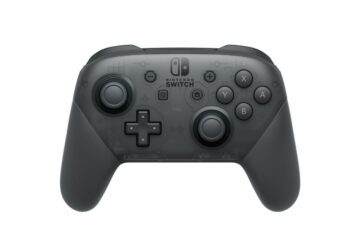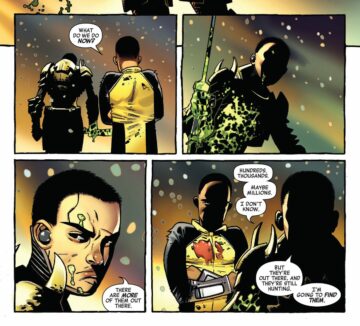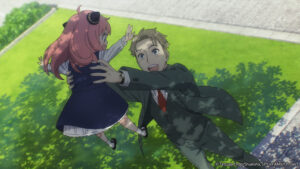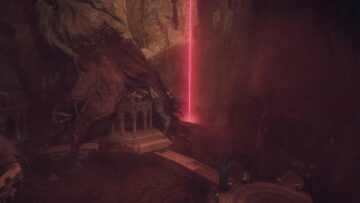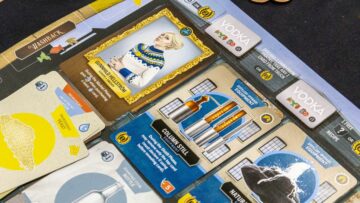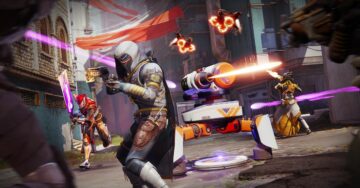It’s no understatement to say puzzles form the backbone of video games as a medium of entertainment.
For me, it started with games like The Legend of Zelda: A Link to the Past, in which dungeons contained numerous mysteries that pushed me to consider, and then reconsider, how I used Link’s vast arsenal of tools to accomplish a task like, say, opening a secret door to a room. And while several adventure games make problem-solving a key aspect of exploring, just plain old puzzles also have played a large role in the history of video games.
It could be the picture book-esque stylings of point-and-click games like Goragoa or the mind-bending worlds of Cocoon, developers continue to shower fans of games with all kinds of brainteasers. Even in the past two years, I’ve seen word games — still puzzles! — take on a new level of widespread popularity through the breakout success of games like the New York Times’ Wordle and now Connections.
There are truly too many puzzle games to choose from. If we really wanted to get philosophical, we could extend this designation to the vast majority of games. So we here at Polygon decided to start by writing up some of our personal favorite puzzle games. From classic match games like Puyo Puyo to the deviously clever visual puns of Baba Is You, here are Polygon’s favorite puzzle games. —Ana Diaz
Baba Is You
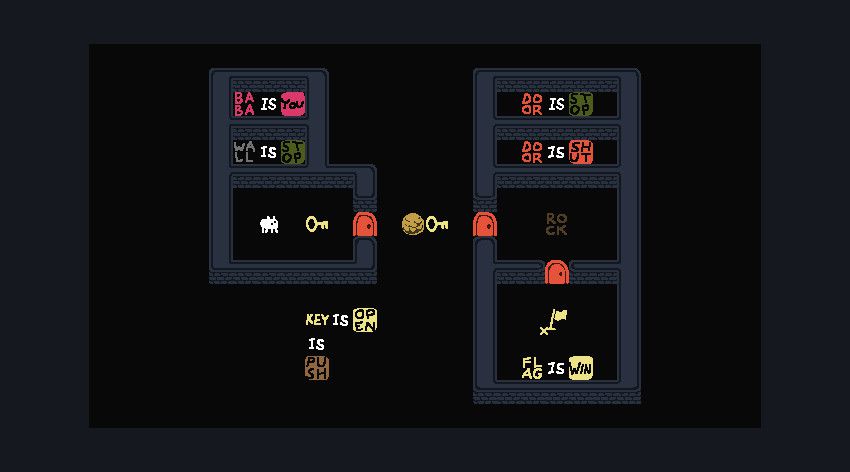
Image: Hempuli Oy
Where to play: Android, iOS, Nintendo Switch, Windows PC
Baba Is You is a word game and an environmental puzzle game, but not in the way that either of those genre terms typically get used.
In this game, the words you select change the environment around you and the entire conditions of the game itself — almost like you’re the level designer. The top-down, 2D game starts simply enough, giving you rules in the form of text on the screen like “Baba is you” (you control a little sprite named Baba), “rock is push” (if you run up against a rock, it’ll move), and “flag is win” (touch the flag to complete the level). But each of those pieces of text can be moved around on screen to spell out different commands, thereby changing the entire world. Pushing these pieces of text to instead make them say “rock is you” turns the rock into a playable character, while Baba simply stands there motionless.
That might not sound too complicated, until the game introduces a ton more objects and actions, thereby allowing you to feel like even more of a galaxy-brained genius upon figuring out how to reorder them in your favor. Like the best puzzle games, Baba Is You will make you feel both smart and stupid constantly — but mostly smart, because you’ll be training your brain to think in ways that are entirely new. —Maddy Myers
The Case of the Golden Idol
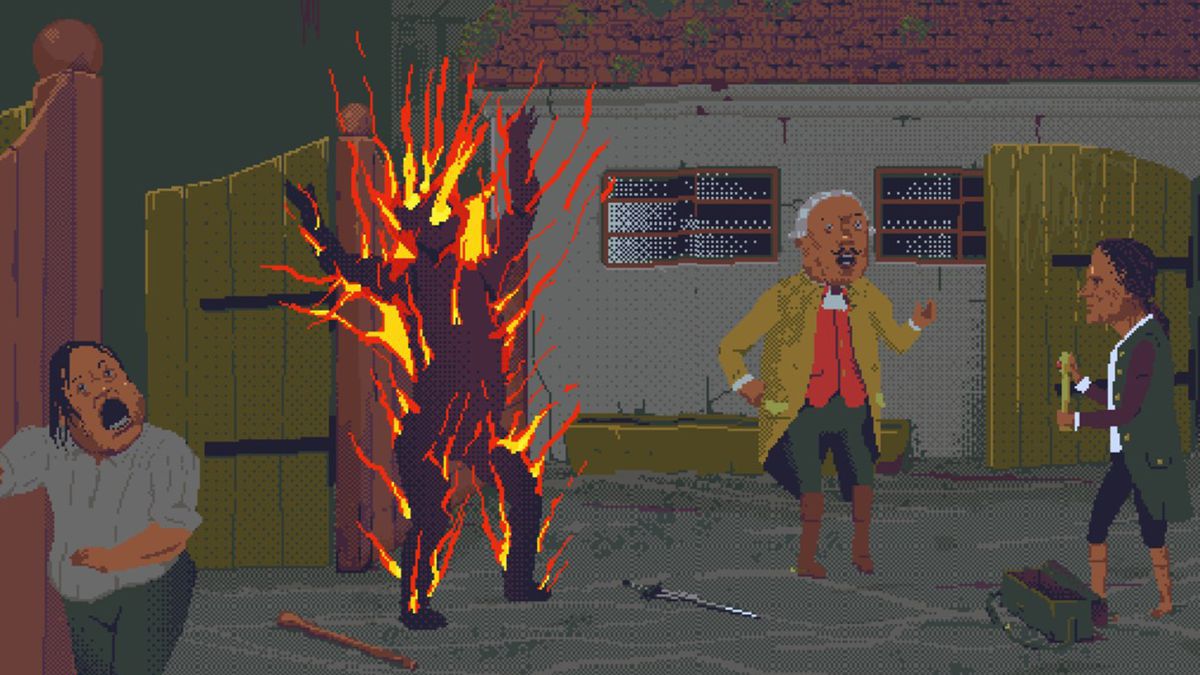
Image: Color Gray Games/Playstack
Where to play: Nintendo Switch, Windows PC
Much like Return of the Obra Dinn (more on that in a sec), the real work of playing The Case of the Golden Idol doesn’t involve anything you do on screen — it happens in your head as you sort through the clues the game has provided.
In this game, it’s not just one event that you need to unravel, but a whole series of mysterious and fantastical murders to solve, one by one. The killings take place over the course of several years, each of them related in some way to a magical object with extraordinary and lethal powers (the titular Golden Idol). Like Obra Dinn, all you get are glimpses of each murder, but not a whole cutscene — just an unsettling, looping animation of the victim’s final moments. As the omnipresent investigator, you can sort through the character’s pockets and explore the victim’s surroundings, which will allow you to put together clues and make an accusation — in the form of a written logbook that has predetermined phrases for you to select.
In that way, Golden Idol involves some process of elimination, since there are only ever so many words that you can put into your logbook to describe the murder’s events, but those words might not make any sense to you until you’ve fully processed the scene and the clues. Again, this is a game that unfolds in your head and not on screen — because once you know whodunit, selecting the words that describe the solution is a total breeze. This is a game that will have you wishing you could erase your memory and play it again. Luckily, there’s some fantastic DLC for it and a sequel on the way. —MM
Cocoon
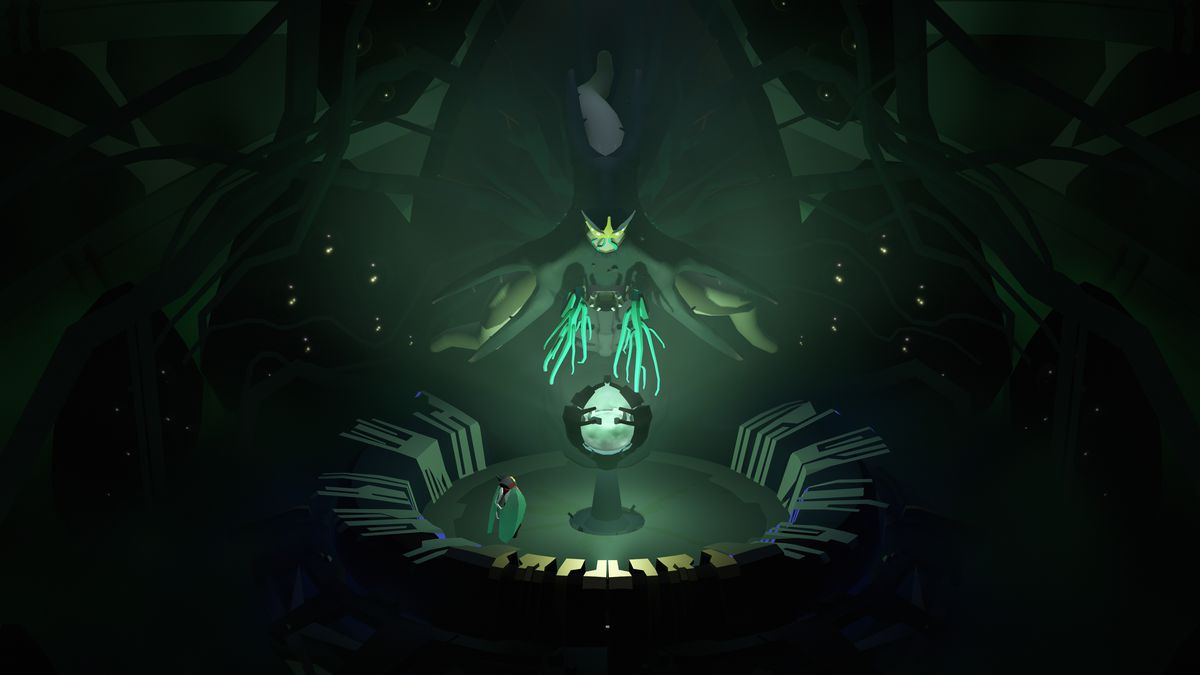
Image: Geometric Interactive/Annapurna Interactive
Where to play: Nintendo Switch, PlayStation 4, PlayStation 5, Windows PC, Xbox One, Xbox Series X
It’s difficult to communicate the terms of a puzzle without using a single line of dialogue or piece of text, yet that’s precisely what Cocoon does throughout its short (four-to-five-hour) but monumentally impressive run time. You play as a cute little bug exploring a series of strange sci-fi worlds using mysterious, glowing orbs to transport yourself to and fro. Environmental hazards abound, but the path beyond each of them always turns out to be head-slappingly simple, requiring you to just look at the minimal tools at your disposal and using them to your advantage. The pulsing synth soundtrack will accelerate in a hopeful direction whenever you get closer to solving a puzzle, which helps. The only frustrating part is that Cocoon still has boss battles in between its oodles of environmental puzzles, and these are fine but not nearly as fun as, well, the puzzles. That’s why you’re here, after all. —MM
Connections
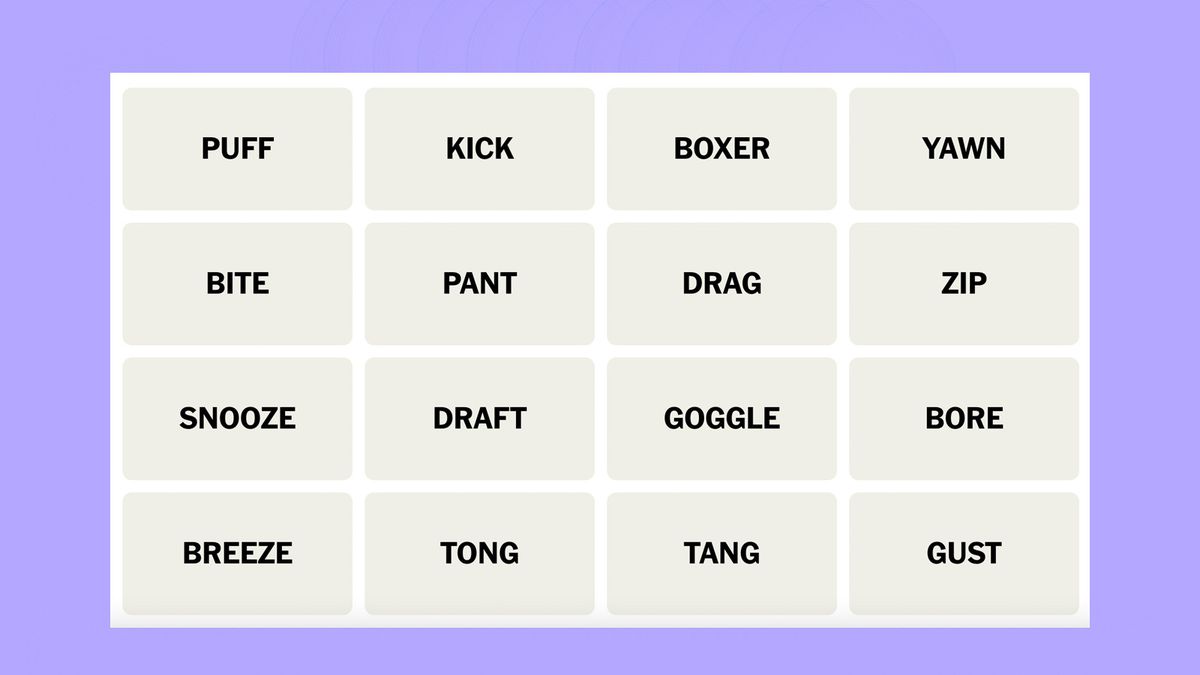
Graphic: Matt Patches/Polygon | Source images: The New York Times
Where to play: NY Times Games
Sometimes you want a gorgeously rendered puzzle game that you can sink hours into on your PC or your console. And other times, you want “grid on phone.”
“Grid on phone” is having a moment in the puzzle genre — trivia games like the Immaculate Grid or Vulture’s Cinematrix have captured the hearts of nerds of all stripes. But for my money [Ed. note: Those games are all free] the New York Times’ daily Connections is the most complete and satisfying version of “grid on phone.”
Each day, players are presented with a four-by-four grid of words. The goal is to find four groups of four connected words: Maybe they rhyme, or have to do with a connected topic, or can all use the same prefix or suffix. Some are harder than others — in each set of four groups, typically two are pretty easy and two are pretty difficult — and Connections editor Wyna Liu is quite skilled at tricking you into thinking you’ve found a group where one doesn’t exist. That level of difficulty is what makes Connections challenging and fun, and when you manage to guess the most difficult group of the day first, it’s a great feeling. —Pete Volk
Grindstone
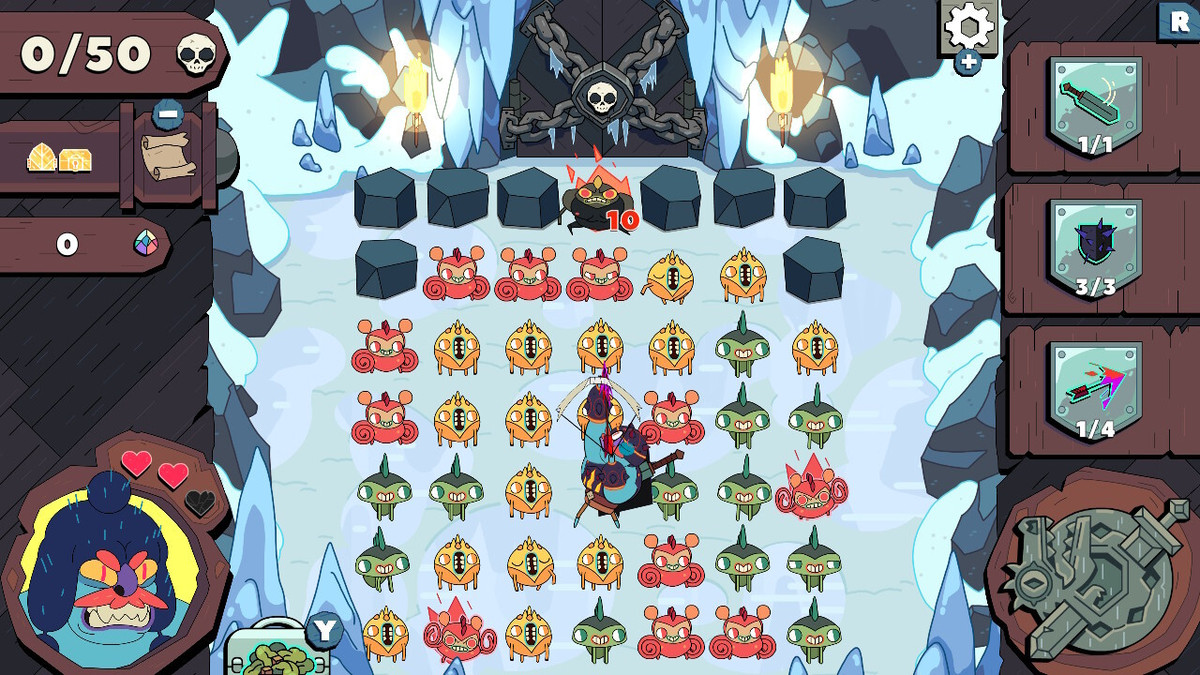
Image: Capybara Games
Where to play: iOS, Nintendo Switch, PlayStation 4, PlayStation 5, Windows PC, Xbox One
Capybara Games’ Grindstone is one of my go-to games if I’m just traveling with my iPad. You play as an ogre-like miner who slays monsters and collects items called grindstones. To collect these stones and complete each level, you’ll chart a path through a corral of monsters by connecting creatures of the same color. If you slay more than 10 monsters in one turn, you’ll be rewarded with a shiny grindstone that allows you to continue your chain attack with a differently colored monster.
Grindstone is polished down to the most minute details. The developers honed in on a strong sense of style that leans into colorful, cartoony art and quirky character design. Even small actions, like slicing through monsters, feels oh-so satisfying as your little ogre grunts and rips through all the little creeps.
I also personally like that you can play through the campaign and upgrade your character. So while it’s a puzzle game, the game does have a progression element where you power up your little miner. What’s more is that this part of the game also introduced certain strategy elements, so you might need to plan out what items and upgrades you’ll want depending on the specific challenge of each level. —AD
Lumines Remastered
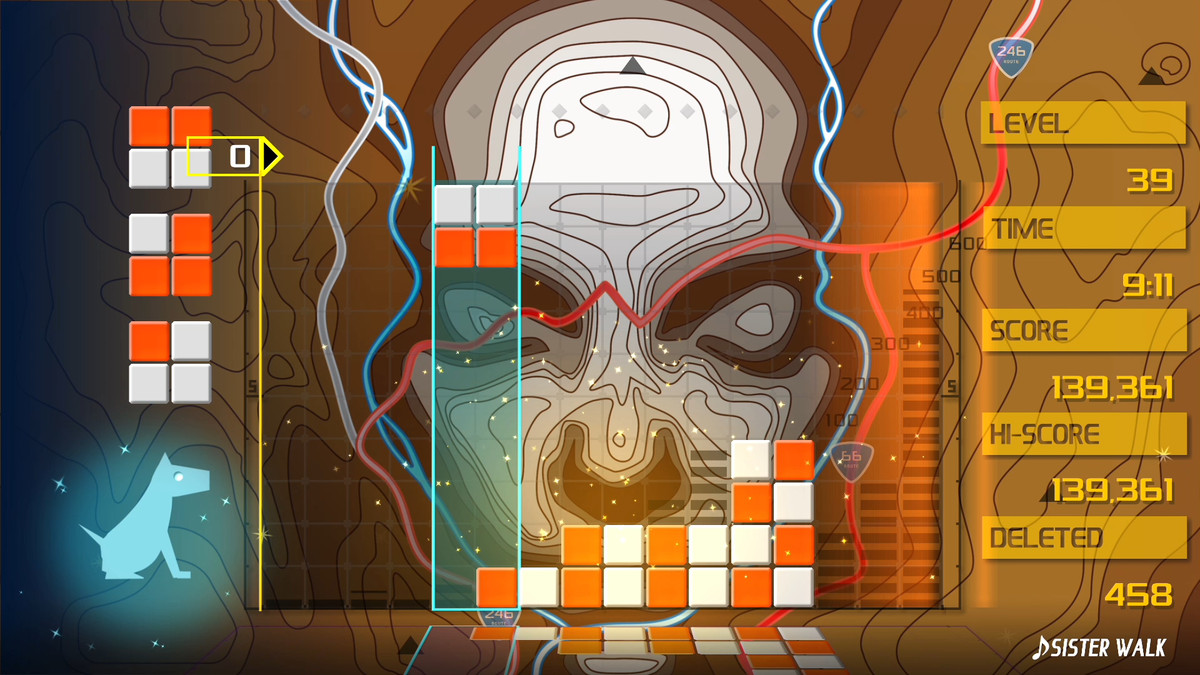
Image: Resonair/Enhance
Where to play: Nintendo Switch, PlayStation 4, Windows PC, Xbox One
Have you ever loved a game that you absolutely suck at? That’s me with Lumines Remastered. On its face, this game has a rather simple premise that will feel comfortable to fans of other falling-block games, but it never fails to kick my ass.
In the main mode, you work with a generously wide board that’s 16 blocks long and 10 high. As you play, a two-by-two square composed of smaller blocks falls from the top of the screen. Each of these squares has its own combination of two different colors of blocks. For example, the first level has a silver-and-orange theme, so one square might have three orange blocks, and then one silver block in the upper right corner. You clear the board by arranging these smaller squares so that the smaller blocks of the same color stack to form other square and rectangular shapes. You lose the game once the blocks stack up and surpass the height of the board.
Lumines Remastered feels great to play and has a great sense of style to boot. The game has a rhythmic pace to it because the squares and rectangles of the same color don’t clear until a cursor aligned with the beat passes over them. I personally think fans of Tetris Effect will love it for its pulsing electronic beats and dazzling visual effects. I might not always get as far as I want, but I’ll always come back for more. —AD
Peggle
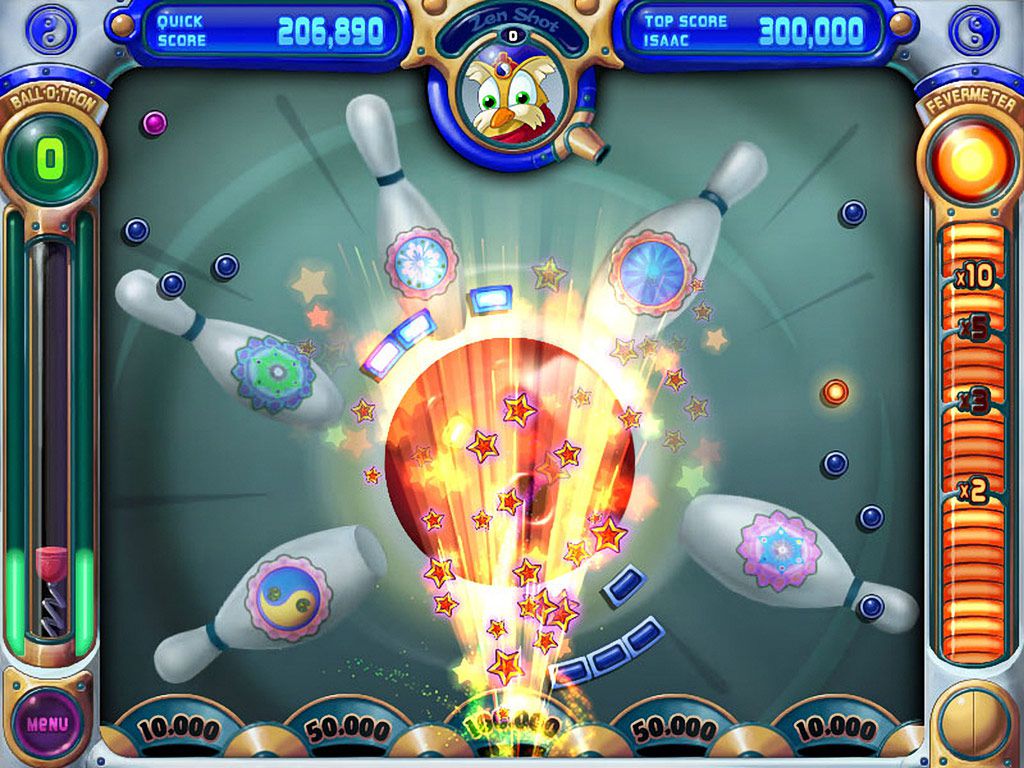
Image: PopCap Games/Electronic Arts
Where to play: Android, iOS, PlayStation 3, Windows PC, Xbox 360
Peggle was released in 2007 and it’s still one of the best puzzle games of all time. A mix of Japanese gambling arcade game pachinko, pinball machines, and centuries-old billiards game Bagatelle, Peggle is played by launching a ball from the top of the screen to bounce around and clear a board full of pegs. It’s a mix of luck and strategy in deciding where to aim the ball to maximize the amount of pegs that are lit up or cleared. It’s pure serotonin when you make huge combos or clear the board — set to an epic rendition of Beethoven’s Symphony No. 9, particularly “Ode to Joy.”
I remember playing Peggle on Xbox Live Arcade, but it’s now available on basically all platforms. PopCap eventually released Peggle Nights and Peggle 2, plus Peggle Blast for mobile devices, among others. From its major success, Peggle has almost become a genre: There’s roguelike Peglin, dungeon crawler Roundguard, and role-playing game Beast Breaker, if you’re looking to spice up the original gameplay. —Nicole Carpenter
Picross
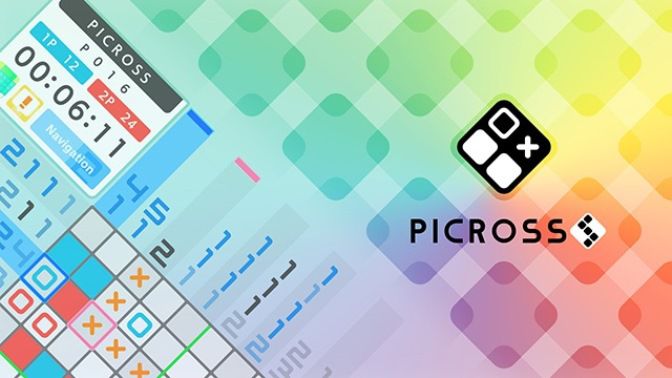
Image: Jupiter
Where to play: Nintendo Switch
Nonograms like Picross are a tried-and-true puzzle format. In Picross games, you fill in boxes on a grid to reveal a picture by using numbered hints assigned to each line. My personal favorite version of it is Sega’s: the Picross S games for Nintendo Switch. Sega released the first Picross S in 2017 and has released more than eight different versions of it since. (I played Picross S4 and 5, and enjoyed those ones specifically.)
Picross games have a laid-back feel that’s notably less frantic than some of the other options on this list. You can learn the basics in minutes and kick back once you do. I personally appreciate how the Picross S series feels great to play in a digital format since it gives you all the notation tools you need to succeed.
Picross would make the perfect match for the sudoku-inclined. I’d also venture to say that its laid-back gameplay and almost pen-and-paper feel would make it a great next step for any fans of word games wanting to try something new. It is the perfect game to play on a lazy Sunday morning as you drink a giant cup of coffee. —AD
Pocket Card Jockey: Ride On!
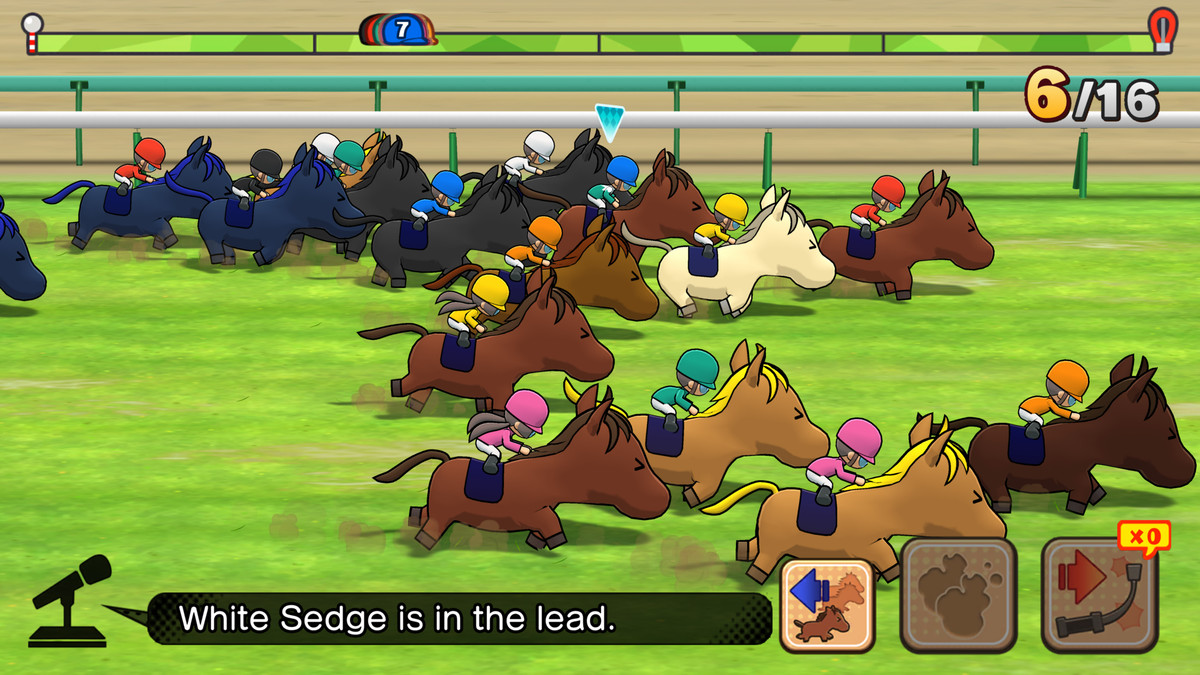
Image: Game Freak/Apple
Where to play: iOS, Nintendo Switch
One of my favorites puzzle game genres is “improbable mashup of solitaire with something else” (see the entry for Regency Solitaire in this list), and you don’t get more improbable than Pokémon developer Game Freak’s collision of frantic, high-speed card-clearing with a surprisingly deep and tactical horse-racing sim. Originally appearing on Nintendo 3DS, Pocket Card Jockey is now available in a remake for iOS (via Apple Arcade) and Nintendo Switch. The game involves clearing hands of cards very quickly against the clock to determine your success in various phases of the horse race, but there’s a load of other stuff going on too, including managing your horse’s positioning on the track, its levels of energy and stamina, and so on. There’s even an involved and lengthy career mode where breeding and stable management comes into play. Super cute and accessible on the surface, Pocket Card Jockey is a deep, hypnotic, and exciting mashup of sports and puzzle game under the surface. —Oli Welsh
Pokémon Puzzle League
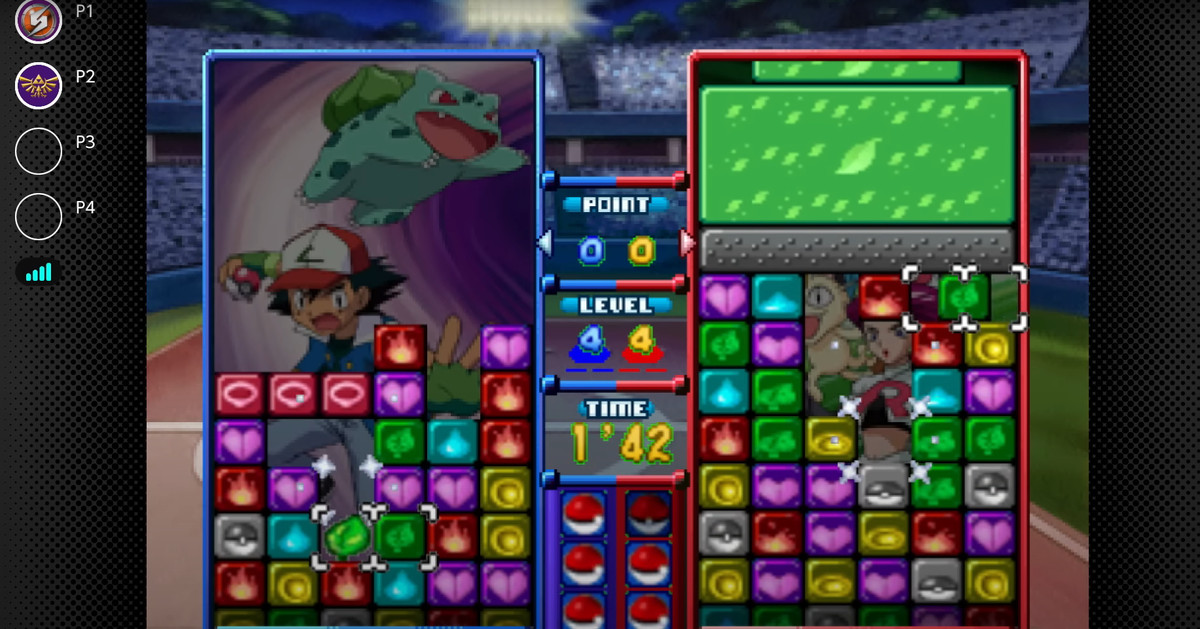
Image: Nintendo
Where to play: Nintendo Switch Online + Expansion Pack
When I’m hanging out with family around the holidays, there’s always one game that comes out. It’s not a sleepy-eyed Mario Kart or anything like that, no — we just love to play Pokémon Puzzle League.
Originally released on Nintendo 64 in 2000, we now enjoy the game by playing it via the Nintendo Switch Online + Expansion Pack subscription. The game is basically Tetris Attack (also known as Panel de Pon) with a Pokémon skin. You navigate a one-by-two cursor that flips the blocks from one spot to another. So if you have a red “fire-type” block sitting to the left of a blue “water-type” block, it will swap their spots so the blue one is on the left and red is on the right. Then, you just try to match up lines of three of the same color or more. When you get into it, the game can take on a dizzyingly fast pace that can hook you in for hours.
With a soundtrack that contains cutesy versions of classic tracks like “Pokémon World” and crunchy animated visuals from the early era of the franchise, it will tickle any longtime fans of the series. However, it still holds up as a great puzzle game and is a joy to play in local co-op with the non-Pokémon lovers in my life. —AD
Puyo Puyo Tetris
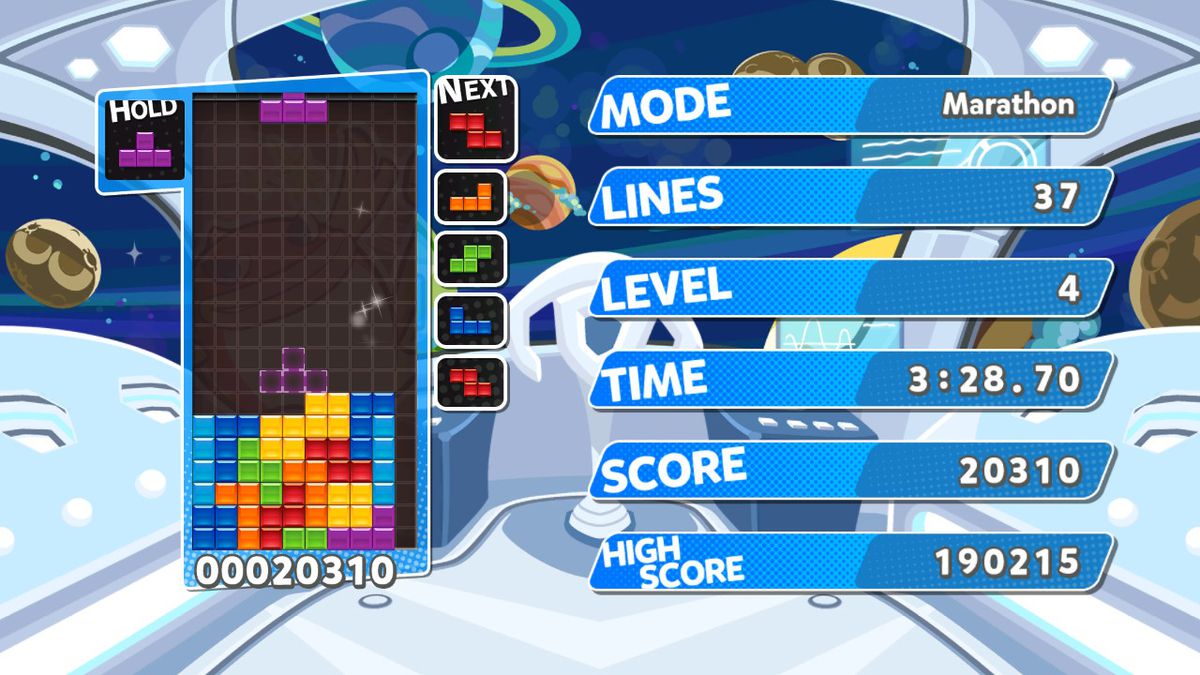
Image: Sonic Team, Bitbaboon/Sega via Polygon
Where to play: Nintendo Switch, PlayStation 3, PlayStation 4, Windows PC, Xbox One
If there is one game on this list that has an uncanny ability to leave me and my friends red-eyed and wondering how it’s already 3:00 a.m., it’s Puyo Puyo Tetris.
The game combines Puyo Puyo — the beloved color-matching game from Sega — and Tetris, the classic falling-block game with tetrominoes. It’s kind of a matter of “if it ain’t broke, don’t fix it,” and Tetris certainly doesn’t need any fixing. Puyo Puyo Tetris (and its accompanying sequel) have long been my couch co-op Tetris game of choice.
While the game does have single-player content, I’ve only ever played it with others. In a match, each person gets to choose between playing with the Puyo Puyo mode or Tetris mode. You can play with up to four people at once, and clearing lines on the board in the Tetris version or matching colors in the Puyo Puyo version sends attacks that fill up your competitors’ boards with gray blocks or Puyos.
Puyo Puyo Tetris blends the two classics excellently, even if my groups tend to skew toward the Tetris side of things. I’ve had friends jump in with Puyo and it provides a new kind of challenge as a Tetris player. The one drawback? Some might find the voice-over of its cartoon characters a tad annoying, but even their grating nature can be endearing in its own way, especially if you’re one to shout into the late hours of the night. —AD
Puzzle & Dragons Story
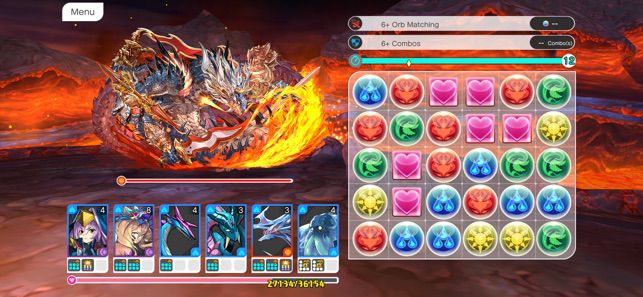
Image: GungHo Online Entertainment
Where to play: iOS
Puzzle & Dragons Story is an Apple Arcade game that combines creature battling and match-3 systems. The classic tile-matching gameplay is where you’ll be attacking the monsters you’re fighting — what you match determines how hard you hit, what element is boosted, or when you heal. It’s one of those games that looks easy, but there’s a lot of strategy involved when you get into the depths.
The franchise has been around since 2012 in several different forms on mobile, but Puzzle & Dragons Story is the latest release, removing the microtransactions from the game — one of the big things the game has been criticized for in the past. Between the dungeons, Puzzle & Dragons Story is filled out with a dramatic narrative that’s easy to consume in small bites, making this one of my top games for whenever I’ve got a spare moment. —NC
Regency Solitaire
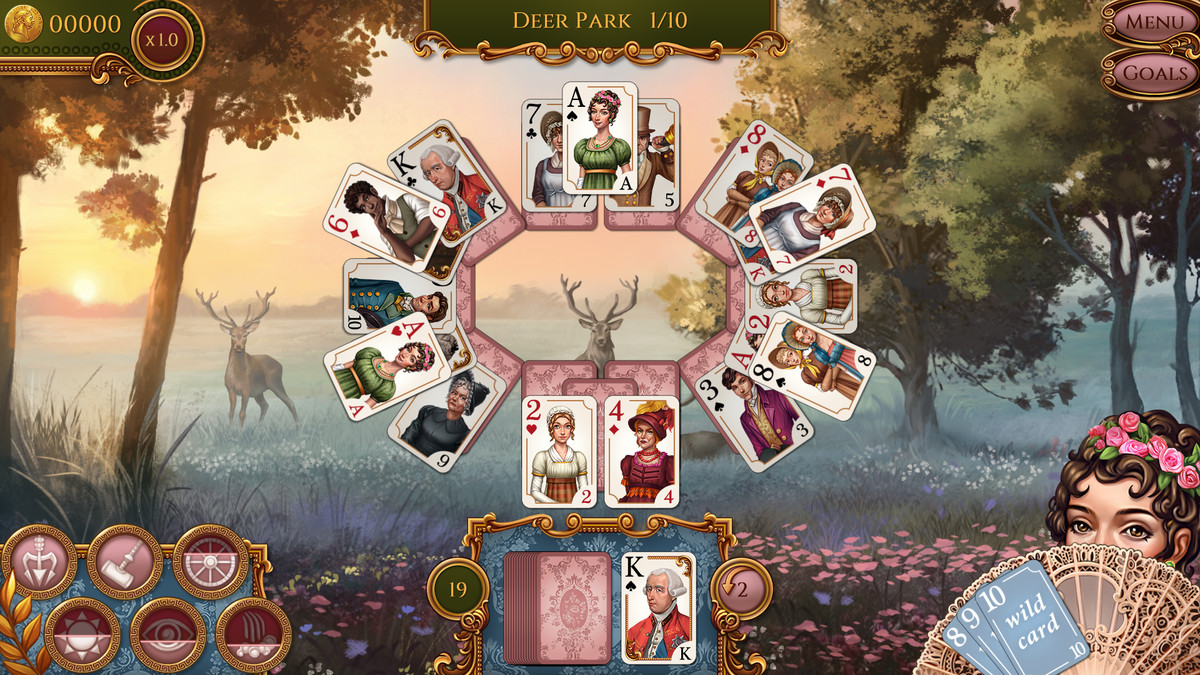
Image: Grey Alien Games
Where to play: Nintendo Switch, Windows PC
For soothing, smooth-brain puzzling in the true casual-gaming tradition, you can’t do better than this elegant solitaire variant with a Jane Austen-inspired storyline. In 2015’s Regency Solitaire and its 2024 sequel you play Bella, a social-climbing debutante whose pursuit of the perfect marital match is punctuated by lots of attractively arranged tableaux of cards to clear by clicking on them. And the clicking feels great — developer Grey Alien Games is a master of this sort of thing, so the crisp sound effects and light arcade-style scoring systems are perfectly tuned to keep you pleasantly engaged, but not too excited. The Austen pastiche is pretty funny, too. There’s not much to choose between the first and second games, but Regency Solitaire 2 looks better on modern displays, and is a tad more refined. (The original is available on Switch and PC; Regency Solitaire 2 is on PC only.) —OW
Return of the Obra Dinn
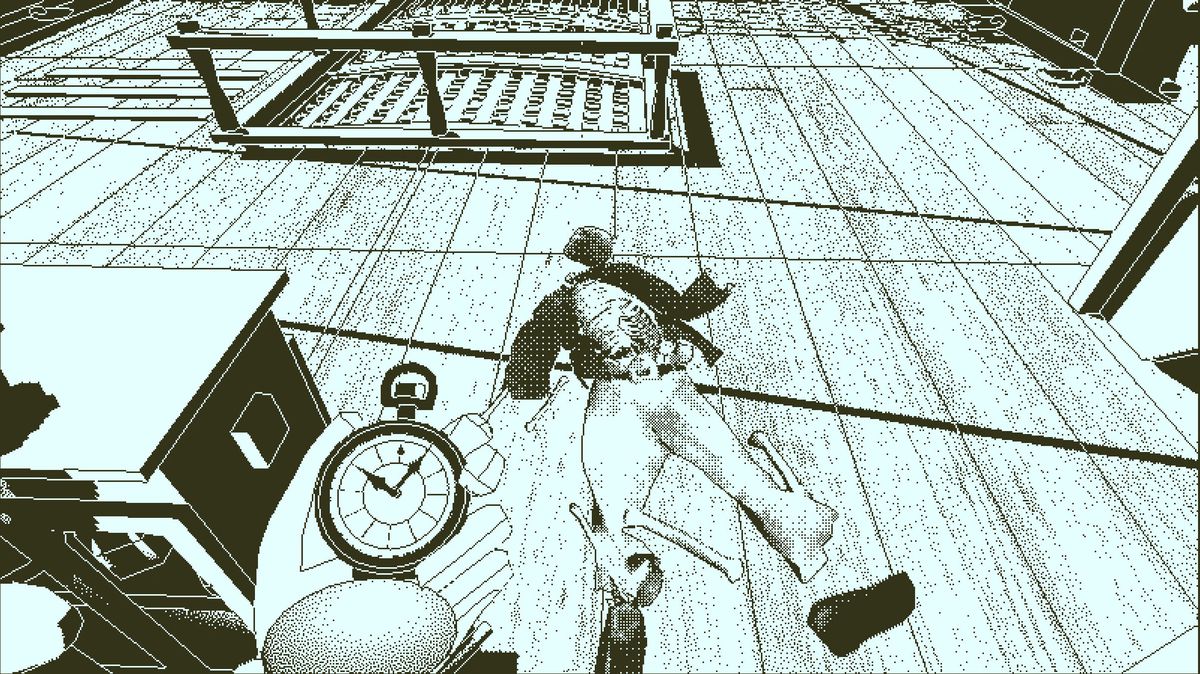
Image: Lucas Pope/3909
Where to play: Nintendo Switch, PlayStation 4, Windows PC, Xbox One
The vessel Obra Dinn left port with 60 souls aboard and returned with none alive. It’s your job to deduce what happened to each member of its crew and how they met their fate. You’re given a crew manifest, some sketches, and a pocket watch. Using this device next to a corpse or other points of interest presents you with a snapshot of how the incident occurred and a bit of dialogue, allowing you to piece together events as you explore more of the ship.
The first handful of deductions are relatively simple, but as you cross names off your list, evidence becomes increasingly obscure, forcing you to fill in the blanks by cross-referencing new information as it becomes available. You have an unlimited amount of time to come to your conclusions before departing, but the Obra Dinn isn’t a particularly hospitable place. From the moment you step aboard, the eerie silence is punctuated only by your footsteps and the groaning of the vessel against the increasingly restless tide. Even with the knowledge that I could leave at any time, I found myself occasionally jumping at shadows and wondering if I wasn’t joined by some spectral passenger.
The first-person perspective might throw someone that’s unfamiliar with the genre, but the simple control scheme and leisurely pace ensure that it remains accessible for anyone looking for a puzzle game that offers an honestly unique experience. —Alice Jovanée
Suika Game
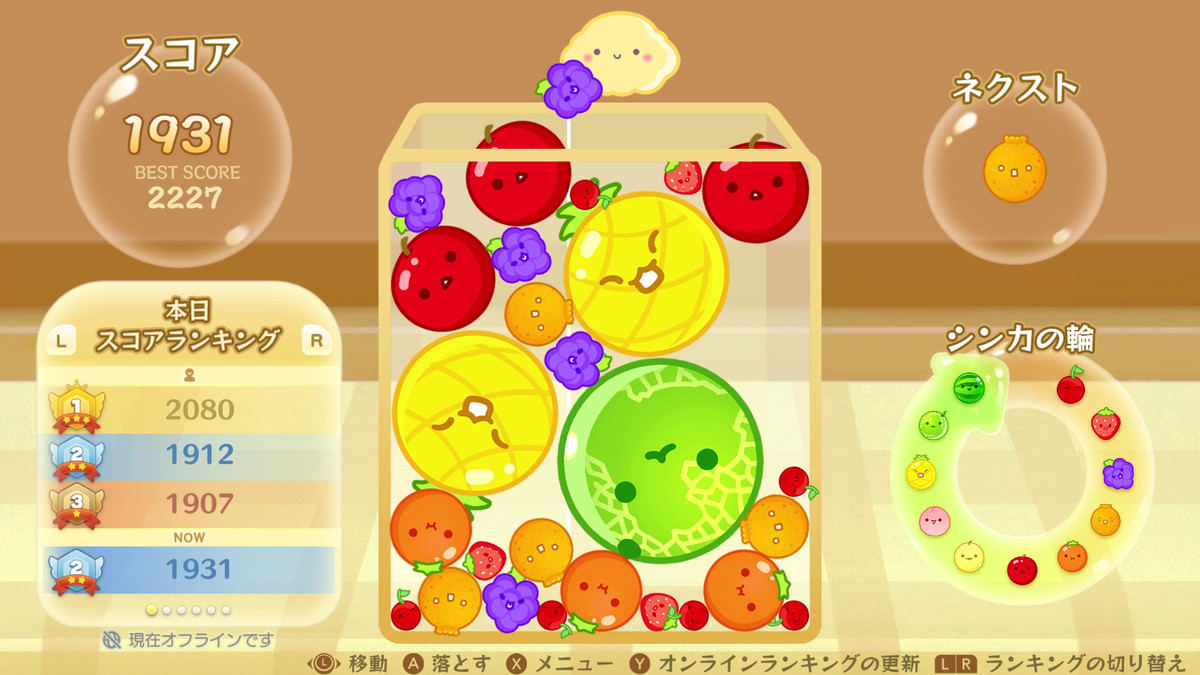
Image: Aladdin X via Polygon
Where to play: Nintendo Switch
Suika Game was one of my most-played games last year, and will likely be in the running in 2024, too. Even with so many hours logged, I’m not good at Suika Game, and I’m not sure I ever will be. And yet, I keep playing — the fruit-merging game has its hooks deep in me. It’s, again, one of those deceptively simple games: Just combine two of the same fruit and keep fruits from spilling out of the box? Easy, right? No! This is like Tetris if it had bounce physics, so you also have to worry about fruits shooting themselves out of the box with a weird bounce. Though I get frustrated, I keep coming back because it is a compelling mix of skill and luck — but likely mostly luck. You can only play Suika Game on Nintendo Switch in the United States right now, but there’s hope for it coming to mobile. —NC
The Witness

Image: Thekla Inc.
Where to play: Android, iOS, PlayStation 4, Windows PC, Xbox One
If you want to go on a philosophical journey into the heart of puzzles as an art form — and who doesn’t? — there is perhaps only one game that can take you there: The Witness, the abstract, first-person puzzle adventure that was designer Jonathan Blow’s follow-up to Braid. In a way it recalls Myst; you wander around a strange, idyllic, deserted island, solving puzzles to unlock new areas. But in The Witness, absolutely all the puzzles, which you access via panels in the game world, are 2D maze puzzles, variations on an original design of Blow’s. Through countless permutations, Blow builds upon this simple puzzle concept, turning it into a language in its own right and a dialogue with the player — like Bach turning a simple melody into the Goldberg Variations. It’s one of the most rigorous and challenging explorations of game design ever, and an essential experience for the true puzzle connoisseur. —OW
- SEO Powered Content & PR Distribution. Get Amplified Today.
- PlatoData.Network Vertical Generative Ai. Empower Yourself. Access Here.
- PlatoAiStream. Web3 Intelligence. Knowledge Amplified. Access Here.
- PlatoESG. Carbon, CleanTech, Energy, Environment, Solar, Waste Management. Access Here.
- PlatoHealth. Biotech and Clinical Trials Intelligence. Access Here.
- Source: https://www.polygon.com/what-to-play/24114511/best-puzzle-games-play-ios-android-windows-playstation-xbox
- 10
- 16
- 2000
- 2012
- 2017
- 2024
- 2D
- 378
- 3DS
- 60
- 9
- 900
- a
- ability
- About
- absolutely
- ABSTRACT
- accelerate
- access
- accessible
- accomplish
- actions
- ADvantage
- Adventure
- after
- again
- Against
- aim
- aladdin
- alien
- aligned
- alive
- All
- All Time
- allow
- Allowing
- allows
- almost
- already
- also
- always
- among
- amount
- amp
- an
- and
- animated
- Animation
- Another
- any
- anyone
- Anything
- appearing
- Apple
- Apple Arcade
- appreciate
- Arcade
- ARE
- areas
- around
- arranged
- Arsenal
- Art
- as
- aspect
- assigned
- At
- attack
- attacks
- available
- back
- Backbone
- background
- ball
- Basics
- battles
- battling
- BE
- beat
- beats
- because
- become
- becomes
- been
- before
- behind
- beloved
- BEST
- Better
- between
- beyond
- BIG
- Bit
- block
- blocks
- blow
- Blue
- board
- Boards
- Boosted
- both
- Box
- boxes
- brain
- breakout
- Breeding
- Bug
- builds
- but
- by
- called
- Campaign
- CAN
- captured
- card
- Cards
- Career
- cartoon
- case
- Cave
- certain
- certainly
- chain
- challenge
- challenging
- change
- changing
- character
- characters
- chart
- choice
- choose
- Classic
- classics
- clear
- clearing
- closer
- Coffee
- collect
- collision
- colorful
- combination
- combine
- combines
- come
- comes
- coming
- communicate
- compelling
- complete
- complicated
- composed
- concept
- conclusions
- conditions
- connected
- connecting
- Connections
- Consider
- Console
- constantly
- consume
- contained
- contains
- content
- continue
- Control
- corner
- corpse
- could
- course
- cover
- creatures
- Crew
- CRISP
- cross
- cup
- Cute
- daily
- day
- De
- decided
- deck
- deep
- depending
- depths
- describe
- Design
- designer
- details
- determine
- Developer
- developers
- device
- Devices
- dialogue
- different
- differently
- difficult
- difficulty
- digital
- direction
- displays
- disposal
- dlc
- do
- does
- door
- down
- Dragon
- dramatic
- Drink
- dungeons
- each
- Early
- easy
- Effect
- effects
- eight
- either
- electronic
- element
- elements
- energy
- engaged
- enjoy
- enjoyed
- enough
- ensure
- Entertainment
- entire
- entirely
- entry
- Environment
- environmental
- Epic
- era
- especially
- essential
- even
- Event
- events
- eventually
- EVER
- Evidence
- Example
- excited
- Exciting
- exist
- expansion
- experience
- explore
- Exploring
- extend
- extraordinary
- Face
- fails
- falls
- family
- fans
- fantastical
- far
- FAST
- Fate
- favor
- favorite
- feel
- feels
- field
- Fighting
- filled
- Final
- find
- fine
- First
- Fix
- For
- forcing
- form
- format
- forms
- found
- four
- Franchise
- Free
- Friends
- from
- front
- fruits
- frustrating
- full
- fully
- fun
- funny
- Gambling
- game
- gameplay
- Games
- Games Like
- Gaming
- generously
- genius
- Genre
- genres
- Get
- gets
- giant
- given
- gives
- Giving
- go
- goal
- going
- golden
- good
- got
- gray
- great
- Green
- Grid
- Grindstone
- Group
- guess
- had
- hands
- happened
- happens
- Hard
- harder
- has
- Have
- having
- head
- heart
- Hearts
- helps
- here
- High
- hints
- history
- HIT
- holds
- holidays
- Honestly
- Hook
- hooks
- hope
- hopeful
- horse
- horses
- hours
- How
- How To
- however
- HTML
- HTTPS
- huge
- i
- ICE
- if
- image
- Images
- impressive
- in
- incident
- Including
- increasingly
- information
- instead
- interest
- into
- introduced
- Introduces
- involve
- involved
- involves
- involving
- iOS
- iPad
- Is
- Island
- IT
- items
- ITS
- itself
- jane
- Japanese
- Job
- joined
- Jonathan
- journey
- joy
- jpeg
- jpg
- jump
- just
- keep
- Key
- kick
- kind
- kinds
- know
- knowledge
- known
- language
- large
- last
- late
- latest
- launching
- layout
- League
- LEARN
- leave
- left
- legend of zelda
- less
- Level
- levels
- Life
- light
- like
- likely
- Line
- lines
- LINK
- List
- Little
- Live
- load
- local
- logged
- Long
- Look
- looking
- looks
- lose
- lot
- lots
- love
- loved
- lovers
- Luck
- Machines
- main
- major
- Majority
- make
- MAKES
- Making
- manage
- management
- managing
- many
- Mario
- Mario Kart
- master
- Match
- matching
- matt
- matter
- maximize
- maybe
- me
- medium
- melody
- member
- memory
- met
- Microtransactions
- might
- miner
- minimal
- minute
- minutes
- mix
- Mobile
- mobile devices
- mode
- Modern
- moment
- moments
- money
- monsters
- more
- morning
- most
- mostly
- move
- moved
- much
- murder
- my
- myself
- mysteries
- mysterious
- named
- names
- narrative
- nature
- navigate
- nearly
- need
- never
- New
- New York
- Next
- Night
- Nintendo
- Nintendo 3DS
- Nintendo 64
- Nintendo Switch
- no
- None
- not
- notably
- note
- now
- numbered
- numerous
- objects
- occurred
- of
- off
- Offers
- Old
- on
- once
- One
- ones
- online
- only
- opening
- Options
- or
- orb
- Orbs
- original
- originally
- Other
- Others
- our
- out
- over
- own
- pace
- pack
- painting
- panel
- panels
- part
- particularly
- passes
- Past
- path
- PC
- People
- perfect
- perfectly
- perhaps
- person
- personal
- personally
- perspective
- phases
- phone
- phrases
- Physics
- picture
- piece
- pieces
- place
- plain
- plan
- Platforms
- plato
- plato data intelligence
- platodata
- platogaming
- play
- played
- player
- players
- Playing
- playing field
- playstation
- PlayStation 3
- playstation 4
- playstation 5
- pleasantly
- Plus
- pockets
- Points
- Polygon
- popularity
- positioning
- power
- powers
- precisely
- predetermined
- presented
- presents
- pretty
- problem solving
- Process
- processed
- progression
- provided
- provides
- punctuated
- pure
- pursuit
- pushed
- pushing
- put
- Puzzle
- puzzle game
- quickly
- quite
- Race
- rather
- Real
- really
- red
- refined
- RELATED
- relatively
- release
- released
- remains
- remastered
- Remember
- removing
- rendered
- return
- reveal
- rewarded
- Ride
- right
- rigorous
- Rock
- Roguelike
- role
- Role-Playing
- room
- rules
- Run
- running
- s
- same
- satisfying
- say
- scene
- scheme
- Sci-Fi
- Screen
- SEC
- second
- Secret
- see
- seen
- Sega
- select
- selecting
- sends
- sense
- sequel
- Series
- set
- several
- shapes
- shooting
- Short
- side
- Silver
- SIM
- Simple
- Simply
- since
- single
- single-player
- Sitting
- skill
- skilled
- Skin
- small
- smaller
- smart
- Snapshot
- So
- solution
- SOLVE
- Solving
- some
- someone
- something
- Sonic
- Sonic Team
- sound
- Soundtrack
- source
- specific
- specifically
- spell
- spice
- Sports
- Spot
- spots
- square
- stable
- stack
- stamina
- stands
- start
- started
- starts
- States
- step
- still
- Stones
- Story
- storyline
- strange
- Strategy
- Stripes
- strong
- style
- succeed
- success
- sunday
- super
- sure
- Surface
- surpass
- surprisingly
- swap
- Switch
- symphony
- Systems
- tactical
- Take
- task
- Team
- tend
- terms
- text
- than
- that
- The
- The Basics
- The Game
- their
- Them
- theme
- themselves
- then
- there
- thereby
- These
- they
- thing
- things
- think
- Thinking
- this
- those
- though
- three
- Through
- Throughout
- throw
- Tide
- time
- times
- to
- To Leave
- together
- Ton
- too
- tools
- top
- topic
- total
- touch
- toward
- track
- tracks
- tradition
- Training
- transport
- traveling
- true
- truly
- try
- tuned
- turn
- turning
- turns
- two
- typically
- under
- unfamiliar
- unique
- United
- United States
- unlimited
- unlock
- unravel
- until
- up
- upgrade
- upgrades
- upon
- upper
- use
- used
- using
- variations
- various
- vast
- venture
- version
- versions
- very
- via
- Video
- video games
- visual
- visuals
- want
- wanted
- wanting
- was
- Watch
- way
- ways
- we
- well
- What
- when
- whenever
- where
- while
- WHO
- whole
- whose
- why
- wide
- widespread
- will
- windows
- Windows PC
- wishing
- with
- without
- witness
- wondering
- words
- Work
- world
- Worlds
- worry
- would
- writing
- written
- X
- xbox
- Xbox Live
- Xbox One
- xbox series
- year
- years
- yet
- york
- you
- your
- yourself
- youtube
- Zelda
- zephyrnet
